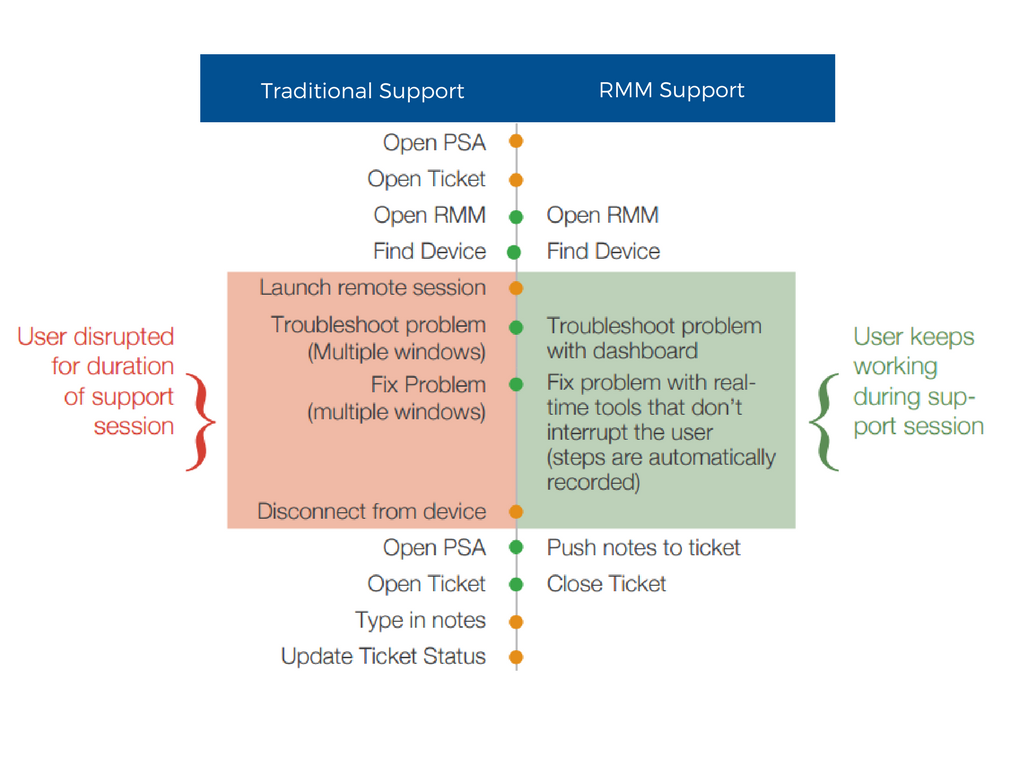Remember when you used to go to the video store to rent the latest blockbuster? You might still find a few video stores around town, but this business model is disappearing fast.
Netflix caused a major disruption in the movie rental industry and many industries were quick to follow suit. Even Microsoft starting offering subscriptions for Microsoft (formerly Office) 365!
Consumers are starting to get used to the notion of subscribing for services instead of buying, a practice known as the Managed Services model. This is a great time for Managed Service Providers (MSP) like you to develop a model that is right for your business.
Why is the managed services model working?
The answer is simple. It’s valuable for both customers and companies.
For customers, it’s all about convenience. They can opt in or out of a service whenever they like and adjust their plan to pay for what they use. Companies also appreciate the predictable revenue that comes with the subscription model plus many other benefits.
Digital Telepathy, a San Diego-based design company, switched to subscription only and increased its revenue by a whopping 300%!
“Instead of signing project agreements or monthly retainers with a detailed scope, we simply offered all of our services under a flat-fee subscription. Clients were initially confused, but once they experienced how our new approach improved our alignment on strategy, design output and working speed, our retention rates catapulted.”
Chuck Longanecker, founder of Digital Telepathy
Not only has this model generated predicable costs and revenue. It also enhances customer relationships.
But Digital Telepathy is only one example. You have to find a model that is the right fit for your market, your business and the products and services you’re selling.
How to build the ultimate managed services business
Wondering how to make a managed services model work for you? We have a few tips to share.
1) Build customer support
The first thing you have to do is to provide outstanding technical support. This will help you get your foot in the door. Businesses rarely look for IT consultants if everything is going well.
One way to offer great support is by using Remote Monitoring and Management (RMM)
IT departments have used remote control software for years. While it is effective, it does have the disadvantage of being disruptive for the end user. Opt for non-intrusive support tools so you can easily troubleshoot problems and resolve them quickly.
This will reduce ticket times and help you make money with help desk support. It will also allow you to build recurring revenue with your customers.

You can get this feature for free, but still charge your customers a solid monthly fee per user.
2) Define your managed services strategy
Your next step is to set yourself apart from the competition. Before you can build a clear strategy, you have to define the specific problem you’re trying to solve.
Once you understand your market’s problems, you’ll be able to provide solutions that are specific and worth paying for. This is your unique value proposition and you should spend time developing it.
Your value proposition should reply to some of these questions:
“Is my solution solving a problem that is…”
- Unworkable
- Unavoidable
- Urgent
- Underserved
While your clients’ problems might not fit all these categories, you should be able to apply your solution to at least 2 out of 4 of them.
You can do this exercise repeatedly to answer different needs for different verticals.
If you need help building an effective strategy, read our article how MSPs can write an effective value proposition in 3 steps
3) Develop a pricing model
Here’s the fun part. Let’s take a look at how you can make money!
The first thing to do is to set up your pricing so you can establish your break even cost and your cost of delivery. Then, evaluate the difference between the costs of an in-house staff and your managed IT services. This will allow you to explain your solution in terms your customers will understand.
Once this is done, standardize the pricing for your core offering. By knowing what your regular and extra costs are, you’ll be able to go to market faster with your solution. It will help you decide on a vendor to develop successful pricing and you’ll shorten your sales cycles. Selling will become easier and repeatable, enabling you to scale your business faster.
Here are some of the most popular ways to price your managed services:
Per-user pricing model
This is the most flexible model. It’s designed for businesses that have employees who work with many devices.
Define a price per user that covers all possible services. It will help you understand your costs. Don’t forget to factor in your price target and break even price.
Here are some key elements you can use to defend your price to customers:
- The complexity of the network
- The employees’ technical skills
- Device age and technology
Being transparent with your customers will help you establish a strong relationship with them.
Flat-fee pricing model
This is known as “cake pricing”. It offers a flat fee for all your services and focuses on the customer experience.
This option is designed for MSPs who outsource IT for their clients.
To build value-based pricing, start with a price per-user concept and add your management fees. No need to disclose your price per user. Just present a single price. Customize your price for each service to maximize your profits. As we mentioned earlier, make sure you explain the cost for in-house staff compared with your services.
Help your customers understand all details of the costs related to IT. Everything from productivity losses to downtime is fair game.
Once your customers see how difficult it could be to run their IT department without you, tell them about your managed services. Explain that your solution will have a minimal impact on their productivity and that you’ll be there to provide your expertise.
Monitoring-only pricing model
This is designed for markets that don’t need much maintenance.
You can use this model to track specific aspects of your customer’s infrastructure and warn them about issues. The advantage here is you can charge extra for support.
Tiered pricing model
This model will let you offer your customers different packages.
Evaluate the costs and resources to provide three basic price points (fewer than 3 is ineffective and more is confusing). Explain how the higher price points offer better service. Otherwise, most customers will opt for the cheapest package.
A la carte pricing model
Use this model to create an optimized solution for everyone. You can offer a standard service with hourly blocks for customers who need more specialized solutions.
Your customers may be overwhelmed by the list of features. That’s why you have to carefully explain each package. Otherwise, you’ll end up with packages that won’t meet your customers’ needs and you’ll spend more time managing contracts than generating new revenue.
One size doesn’t fit all
Remember, what works for a fellow MSP won’t necessarily work for you. Being flexible will make you more competitive.
Keep working on the easy entry point (support) to display your IT muscle. Explain your unique value proposition in detail and prepare a pricing model for it. This will lead you to long-term success.





